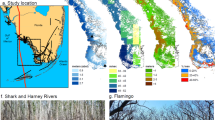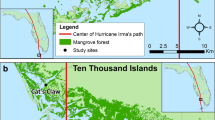Abstract
Hurricanes are a frequent disturbance in the western Atlantic impacting coastal forest structure and persistence. This study addressed the hypothesis that periodic hurricane-associated winds and storm surges can interact with sea-level rise to cause the demise of coastal pine forests, based on the response of the Florida Keys’ last extensive tract of slash pine (Pinus elliottii var. densa) following Hurricane Irma (September 2017). Irma’s winds reached Category 4 strength in the study area on Big Pine Key, and storm surge flooded the island’s low limestone surface with salt water for the third time in 20 years, including Hurricanes Georges in 1998 and Wilma in 2005. Total mortality was 32% and was concentrated in the largest trees. Broken and uprooted trees that died immediately were distributed randomly across the elevation gradient, but trees without major stem damage that succumbed later occupied lower elevations. The extensive salt water flooding at low elevations was likely an agent of the mortality of slash pine, a fresh water–dependent species. Mortality due to Hurricane Irma contributed to a 1998–2018 decline in pine tree density and biomass of 74% and 80%, respectively. These dynamics were characterized by pine recruitment that was minimal in comparison with the three hurricane-driven mortality episodes. The data suggest that the 6 cm sea-level rise over the period exacerbated storm surge mortality by ponding salt water over more of the land surface, and the resulting scarcity of mature trees contributed to recruitment failure. In effect, the population declined at each disturbance, sea-level rise magnified these losses, and the local resilience of the population, i.e., its capacity to recover, was exceeded.








Similar content being viewed by others
References
Bates, D., M. Maechler, B. Bolker, and S. Walker. 2015. Fitting linear mixed-effects models using lme4. Journal of Statistical Software 67 (1): 1–48.
Bender, M.A., T.R. Knutson, R.E. Tuleya, J.J. Sirutis, G.A. Vecchi, S.T. Garner, and I.M. Held. 2010. Modeled impact of anthropogenic warming on the frequency of intense Atlantic hurricanes. Science 327 (5964): 454–458.
Beven, J.L., II, L.A. Avila, E.S. Blake, D.P. Brown, J.L. Franklin, R.D. Knabb, R.J. Pasch, J.R. Rhome, and S.R. Stewart. 2008. Atlantic hurricane season of 2005. Monthly Weather Review 136 (3): 1109–1173.
Boose, E.R., E.F. Boose, and A.L. Lezberg. 1998. A practical method for mapping trees using distance measurements. Ecology 79 (3): 819–827.
Boose, E.R., M.I. Serrano, and D.R. Foster. 2004. Landscape and regional impacts of hurricanes in Puerto Rico. Ecological Monographs 74 (2): 335–352.
Cade, B.S., and B.R. Noon. 2003. A gentle introduction to quantile regression for ecologists. Frontiers in Ecology and the Environment 1 (8): 412–420.
Cangialosi, J. P., A. S. Latto, and R. Berg. (2018). Hurricane Irma (30 August - 12 September 2017). Tropical Cyclone Reports, National Hurricane Center.
Chambers, J. M., and T.J. Hastie. 1992. Statistical models in S. Wadsworth & Brooks/Cole. 624 pp.
Church, J.A., and N.J. White. 2006. A 20th century acceleration in global sea-level rise. Geophysical Research Letters 33: LO1602 1–4.
Ellison, A.M., M.S. Bank, B.D. Clinton, E.A. Colburn, K. Elliott, C.R. Ford, D.R. Foster, B.D. Kloeppel, J.D. Knoepp, G.M. Lovett, J. Mohan, D.A. Orwig, N.L. Rodenhouse, W.V. Sobczak, K.A. Stinson, J.K. Stone, C.M. Swan, J. Thompson, B. von Holle, and J.R. Webster. 2005. Loss of foundation species: consequences for the structure and dynamics of forested ecosystems. Frontiers in Ecology and Environment 3 (9): 479–486.
Francis, J.K., and A.J.R. Gillespie. 1993. Relating gust speed to tree damage in Hurricane Hugo, 1989. Journal of Arboriculture 19: 368–373.
Gardner, L.R., W.K. Michener, E.R. Blood, T.M. Williams, D.J. Lipscomb, and W.H. Jefferson. 1991. Ecological impact of Hurricane Hugo - salinization of a coastal forest. Journal of Coastal Research 8: 301–317.
Gholz, H.L., and R.F. Fisher. 1982. Organic matter production and distribution in slash pine (Pinus elliottii) plantations. Ecology 63 (6): 1827–1839.
Gresham, C.A., T.M. Williams, and D.J. Lipscomb. 1991. Hurricane Hugo wind damage to southeastern US coastal forest tree species. Biotropica 23 (4a): 420–426.
Halekoh, U., and S. Højsgaard. 2014. A Kenward-Roger approximation and parametric bootstrap methods for tests in linear mixed models–the R package pbkrtest. Journal of Statistical Software 59: 1–32.
Halley, R.B., H.L. Vacher, and E.A. Shinn. 2004. Geology and hydrology of the Florida Keys. In Geology and Hydrogeology of Carbonate Islands, ed. H.L. Vacher and T. Quinn, 217, 948–248. Elsevier.
Harley, G.L., J.T. Maxwell, and G.T. Raber. 2015. Elevation promotes long-term survival of Pinus elliottii var. densa, a foundation species of the endangered pine rockland ecosystem in the Florida Keys. Endangered Species Research 29 (2): 117–130.
Holland, G.J. 1980. An analytic model of the wind and pressure profiles in hurricanes. Monthly Weather Review 108 (8): 1212–1218.
Keim, B.D., R.A. Muller, and G.W. Stone. 2007. Spatiotemporal patterns and return periods of tropical storm and hurricane strikes from Texas to Maine. Journal of Climate 20 (14): 3498–3509.
Kiflai, M., D. Whitman, D.E. Ogurcak, and M.S. Ross. In review. The effect of Hurricane Irma storm surge on the freshwater lens on Big Pine Key, Florida, using electrical resistivity tomography. Estuaries and Coasts.
Landsea, C.W., and J.L. Franklin. 2013. Atlantic hurricane database uncertainty and presentation of a new database format. Monthly Weather Review 141 (10): 3576–3592.
Little, S., J.J. Mohr, and L.L. Spicer. 1958. Salt-water storm damage to loblolly pine forests. Journal of Forestry 56 (1): 27–28.
O’Brien, J.J., J.K. Hiers, M.A. Callaham Jr., R.J. Mitchell, and S.B. Jack. 2008. Interactions among overstory structure, seedling life-history traits, and fire in frequently burned neotropical pine forests. Ambio 37 (7–8): 542–547.
Ogurcak, D.E. 2015. The effect of disturbance and freshwater availability on lower Florida Keys’ coastal forest dynamics. FIU Electronic Theses and Dissertations. 2288.
Ogurcak, D.E., and R.M. Price. 2019. Groundwater geochemistry fluctuations along a fresh-saltwater gradient on the carbonate islands of the lower Florida Keys. Chemical Geology.
Oliver, C.D. 1980. Forest development in North America following major disturbances. Forest Ecology and Management 3: 153–168.
Pasch, R.J., L.A. Avila, and J.L. Guiney. 2001. Atlantic hurricane season of 1998. Monthly Weather Review 129 (12): 3085–3123.
Pickett, S.T.A., J. Kolasa, J.J. Armesto, and S.L. Collins. 1989. The ecological concept of disturbance and its expression at various hierarchical levels. Oikos 54 (2): 129–136.
Platt, W., G.W. Evans, and S.L. Rathbun. 1988. The population dynamics of a long-lived conifer (Pinus palustris). American Naturalist 131 (4): 491–525.
Platt, W., R.F. Doren, and T.V. Armentano. 2000. Effects of hurricane Andrew on stands of slash pine (Pinus elliottii var. densa) in the everglades region of South Florida (USA). Plant-Ecology 146 (1): 43–60.
R Core Team. 2017. R: a language and environment for statistical computing. R Foundation for statistical computing, Vienna, Austria. URL http://www.R-project.org/.
Rebenack, C.E., P. Cherubini, and W.T. Anderson. 2018. Developing a carbon isotope chronology for a coastal subtropical tree species with variable subannual tree-ring growth. Journal of Coastal Research 34 (4): 828–842.
Reed, D.D., H.O. Liechty, and A.J. Burton. 1989. A simple procedure for mapping tree locations in forest stands. Forest Science 35 (3): 657–662.
Robertson, W., and K. Zhang. 2007. Big pine key survey commissioned by the nature conservancy: Airborne LIDAR data and digital elevation models of Big Pine Key, Florida. Miami: International Hurricane Research Center Florida International University.
Ross, M.S., O’Brien, and L.J. Flynn. 1992. Ecological site classification of Florida Keys terrestrial habitats. Biotropica 24: 488–502.
Ross, M., J.J. O’Brien, and L. da Silveira Lobo Sternberg. 1994. Sea-level rise and the reduction in pine forests in the Florida Keys. Ecological-Applications 4 (1): 144–156.
Ross, M.S., J.J. O’Brien, R.G. Ford, K. Zhang, and A. Morkill. 2009. Disturbance and the rising tide: the challenge of biodiversity management on low-island ecosystems. Frontiers in Ecology and the Environment 7 (9): 471–478.
Ruiz, P. L., M. S. Ross, and J. P. Sah. 2001. Population dynamics of Pinus elliottii var densa in Everglades Nation Park: a case for less frequent prescribed fire. Abstract. Natural Areas Association Conference. Cape Canaveral, FL. Oct. 2001.
Sah, J.P., M.S. Ross, J.R. Snyder, and D.E. Ogurcak. 2010. Tree mortality following prescribed fire and a storm surge event in slash pine (Pinus elliottii var. densa) forests in the Florida Keys, USA. International Journal of Forestry Research 2010, Article ID 20495; 13 pp: 1–13. https://doi.org/10.1155/2010/204795.
Shea, D.J., and W.M. Gray. 1973. The hurricane’s inner core region. I. Symmetric and asymmetric structure. Journal of Atmospheric Science 30 (8): 1544–1564.
Snyder, J.R., A. Herndon, and W.B. Robertson. 1990. Chapter X: South Florida rocklands. In Ecosystems of Florida, ed. R.L. Myers and J.J. Ewel, 230–277. University of Central Florida Press.
Snyder, J.R., M. S. Ross, S. Koptur, and J. P. Sah. 2005. Developing ecological criteria for prescribed fire in South Florida pine rockland ecosystems. Open File Report OF 2006–1062, U.S. Geological Survey.
Sternberg, L.d.S.L., N. Ish-Shalom-Gordon, M. Ross, and J. O’Brien. 1991. Water relations of coastal plant communities near the ocean/freshwater boundary. Oecologia 88 (3): 305–310.
Venables, W.N., and B.D. Ripley. 2002. Modern applied statistics with S. 4th ed. New York: Springer ISBN 0-387-95457-0.
Wells, B.W., and I.V. Shunk. 1938. Salt spray: an important factor in coastal ecology. Bulletin of the Torrey Botanical Club 65 (7): 485–492.
Williams, K., Z. S. Pinzon, R. P. Stumpf, and E. A. Raabe. 1999. Sea-level rise and coastal forests on the Gulf of Mexico. Open File Report 99–441, U. S. Geological Survey.
Acknowledgments
We acknowledge the logistical support of the National Key Deer Refuge, especially to Dan Clarke, Christine Ogura, and Kate Watts. We are indebted to the students and technicians, too many to name here, without which this long-term research product would not have been impossible. Dean Whitman, Michael Kiflai, and Keqi Zhang were generous with their data and technical advice on groundwater and storm surge dynamics. This is contribution number 919 from the Southeast Environmental Research Center in the Institute of Water & Environment at Florida International University.
Funding
This work was supported by the National Key Deer Refuge (Cooperative Agreement Award No. F18AC00088).
Author information
Authors and Affiliations
Corresponding author
Additional information
Communicated by Just Cebrian
Rights and permissions
About this article
Cite this article
Ross, M.S., Ogurcak, D.E., Stoffella, S. et al. Hurricanes, Storm Surge, and Pine Forest Decline on a Low Limestone Island. Estuaries and Coasts 43, 1045–1057 (2020). https://doi.org/10.1007/s12237-019-00624-z
Received:
Revised:
Accepted:
Published:
Issue Date:
DOI: https://doi.org/10.1007/s12237-019-00624-z




